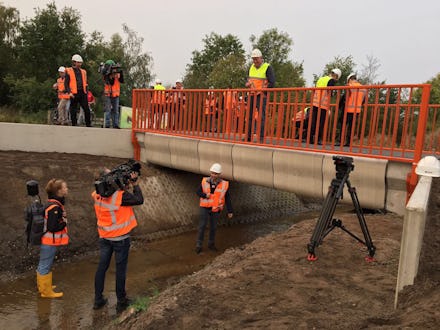How the Netherlands’ 3-D printed bridges could change cities around the world

3-D printing isn’t just for fidget spinners and snacks. In Gemert, Netherlands, construction company BAM Infra used 3-D printing to create a 26-foot bridge that can support up to two tons. It’s not ideal for cars, but it provides plenty of support for someone to walk or cycle over it.
A video uploaded to BAM’s Vimeo channel shows the creation of the bridge: from the 3-D printer using concrete to sculpt the bridge’s design, to the final product being placed in the real world.
“We are looking to the future, searching for a newer, smarter approach to addressing infrastructure issues and making a significant contribution to improving the mobility and sustainability of our society,” Marinus Schimmel, head of BAM Infra, said in a statement, according to the Guardian.
Making a bridge this way — using computers to fill in concrete only where it’s needed, instead of into a mold — requires fewer materials and fewer hours of labor. 3-D printing experts said the technology could be a breakthrough for cost-efficient bridge production towards a bold new method of city construction, paving the way for bigger, more complex bridge structures.
A bridge to the future
Bram de Zwart, CEO of 3D Hubs, a service that helps its users locate 3-D printers, said 3-D printed bridges like BAM Infra’s will likely come to larger projects. In a phone interview, he raved about the fortitude of the Netherlands’ bridge and why it works: “The strength is very much dependent on the direction of the layers. In this case, the layers are in a vertical direction, meaning it can withstand force very well.”
This method will offer numerous advantages to all bridge creation, de Zwart said. “[3-D printing] will allow for more design freedom because you’re designing layer by layer. It also requires less material for the same functionality, so you’re saving weight and material. Also, as 3-D printing becomes more automated, we can make them for cheap.”
“3-D printing requires less material for the same functionality, so you’re saving weight and material.”
The CEO pointed to 3-D printing-assisted house creation when explaining these benefits. “The design freedom of making a 3-D printed house can lead to a very isolating structure, keeping out heat or cold,” de Zwart said. “This would require less energy to heat or cool the house. You can make a really strong, solid structure instead of requiring multiple bricks and other smaller pieces.” The combination of stronger structures and fewer materials could be the future of bridge-building on a slim budget.
However, there is a downside to automation like this, de Zwart said: more jobs for robots and fewer jobs for people.
Despite some reservations, experts are excited for what’s next
Experts at 3-D printer maker Makerbot, however, said they were skeptical of just how much money BAM Infra saved on building a bridge using this method of 3-D printing.
“It wasn’t 3-D printed on the spot,” Josh Snider, a spokesperson for Makerbot, said over the phone, “it was prefabbed somewhere else with 3-D printing methods — as you see in the layer lines on the concrete’s side. But you could have achieved the same thing, only quicker, by just pouring concrete into molds and then assembling it on site the way this bridge was assembled.”
Still, Snider was optimistic about what BAM Infra’s bridge will lead to. He and his colleague Felipe Castañeda, industrial and user experience designer at Makerbot, said in a phone interview that fully 3-D printed structures will lead to production that requires fewer materials overall. It will also allow for more intricate designs, either for aesthetics or for fitting into a particular shape or opening.
How many years until we see a major 3-D printed bridge come to a U.S. city? “It’s difficult to say,” Castañeda said. “It sounds like a pie-in-the-sky idea, but as soon as you have more of these real examples showing how this all could work, [it] accelerates the process. It could be anywhere from 10 to 20 years.”